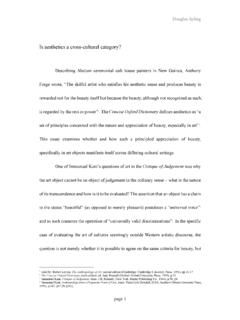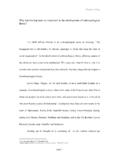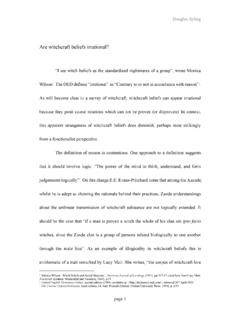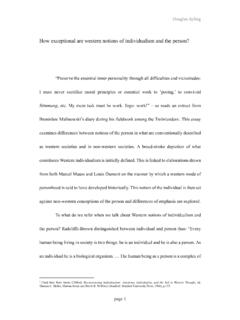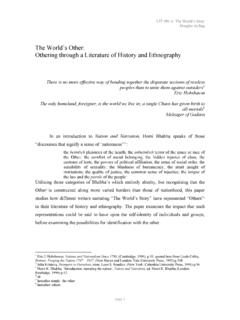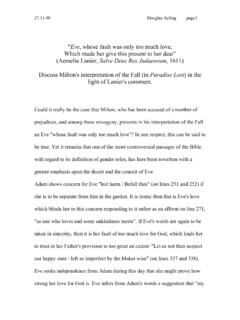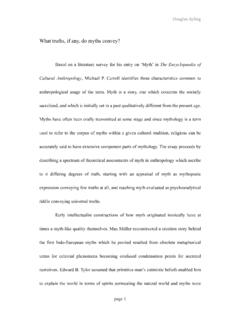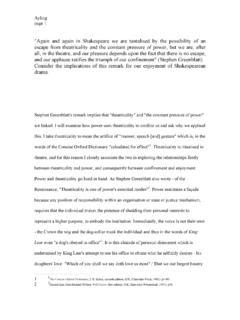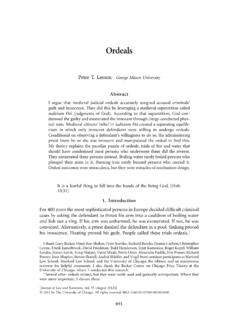Transcription of What use is ritual - Ayling
1 Douglas Ayling what use is ritual ? You are not our king yet; for a little while we will do what we please with you. By-and-by we shall have to do your will . Paul B. Du Chaillu describes the ceremony surrounding the elevation of a prospective king in Gaboon 1 and Victor Turner describes a similar rite called Kumukindyila among the Kanongesha of the Ndembu where the Chief-elect is reviled thus: Meanness and theft are all you have! Yet here we have called you and we say that you must succeed to the chieftainship 2. In this essay I investigate what ritual is and what purposes it may be thought to serve based on the theoretical foundations of Robert Hertz, Arnold van Gennep, and Turner.
2 I then relate this theory to contemporary analysis undertaken by Susan Wright describing the effects of ritual upon its participants in the resurrection of the Ironstone Mining Annual Demonstration day in West Moorside. In the entry on ritual by Elizabeth S. Evans in The Encyclopaedia of Cultural Anthropology, it is noted that ritual has slipped its original moorings in the elaboration of religious practice such that its contemporary usage in anthropology identifies formal, patterned, and stereotyped public performances 3. For Durkheim, it was the heightened 1. Paul B. Du Chaillu, Explorations and Adventures in Equatorial Africa (New York: Harper, 1868), ; cited here from Victor Turner, The ritual Process: Structure and Anti-Structure (New York: Aldine de Gruyter, 1969), 2.
3 Victor Turner, The ritual Process (New York: Aldine de Gruyter, 1969), 3. Elizabeth S. Evans, ritual ', The Encyclopaedia of Cultural Anthropology, ed. David Levinson, Melvin Ember (New York, Henry Holt and Company, Inc., 1996), page 1. Douglas Ayling reality of collective effervescence catalysed by the public performance of ritual which enables the construction and maintenance of social solidarity. Claude L vi-Strauss, Edmund Leach and Mary Douglas developed Durkheim's definition along lines which emphasised the role of ritual in affirming social stability through the public communication of symbols and categories.
4 Nonetheless, Durkheim was integral to overcoming a sacred ritual / secular ritual categorisational dichotomy in anthropology by arguing that sacredness was the result of processes of sacralization and hence that nothing was inherently sacred until society worked to make it so. Thus Eric Hobsbawm and Terrence Ranger would describe in terms consistent with the discipline the rituals of nation-building and Raymond Williams would see in ritual the articulation of political power. However defining ritual as formal, patterned, and stereotyped public performances does not help us to identify what might make ritual distinctive as distinguished from routine repetitive acts to which subjects attach no heightened significance.
5 That Evans writes Is ritual , in the end, something that we all know when we see it, but find it impossible to articulate or to definitively define? suggests that those who use the term ritual to categorise a set of social phenomena are doing so from an approximate collective understanding of what ritual does. page 2. Douglas Ayling Robert Hertz in his study of the rituals associated with death presents explanations of death rituals based on two elements out of a possible three in each case. The three elements by which he structures the first section of Contribution une tude sur la repr sentation collective de la mort' are the body, the soul and the living.
6 Thus an explanation for rituals deriving from fear of the corpse could be adduced from consideration of the kinds of relationship being severed by death. Considering the living and the corpse, the death of an individual rents the social fabric and if the person held a position of power may destabilise society. Considering the soul and the corpse, the physical remainder of the decaying body is an unresolved and threatening intimation of further death that serves to characterise the transition of the soul to the afterlife as gradual rather than complete and thereby implies a contagion. Considering the soul and the living, the contradiction which must be resolved is that the social personhood of the deceased still exists in the self-conceptions of the living and in the configuration of relationship networks.
7 Goody has noted how among the LoDagaa of West Africa the funerary service includes a method for redesignating the roles of friend or lover. It could be said of Hertz'. description of death qua social phenomena as a dual and painful process of mental disintegration and synthesis 4 that rituals surrounding death serve to reorganise, distort 4. Robert Hertz, A contribution to the study of the collective representation of death', Death and the Right Hand, trans. Rodney and Claudia Needham (Aberdeen: Cohen and West, 1960), page 3. Douglas Ayling and reiterate time so that the discrete event of death occurs over a social time commensurate to the emotional and psychological management it necessitates.
8 Van Gennep's tripartite division of the phases of ritual into stages of separation, transition and reintegration identifies a trajectory common to rites of passage. The transitional stage is a liminal one in which the subjects have been taken out of quotidian life, separated from mainstream society and isolated. During this stage they will be divorced from conventional notions of time and space and will mimetically enact a facet of the crisis which precipitated the separation. In van Gennep's study of rites of passage relating to pregnancy, childbirth, initiation, betrothal, marriage and death, the spatial quality of the ritual trajectory of participants relative to society is also related to physical thresholds such as the limens separating social statuses from each other: doorways, gates and walls.
9 In van Gennep's analogy, society is like a house in which the partitions between roles are thinner the more civilised the society In a semicivilized society, on the other hand, sections are carefully isolated, and passage from one to another must be made through formalities and ceremonies which show extensive parallels to the rites of territorial passage 5. Whether in fact greater complexity in society would not conversely by definition 5. Arnold van Gennep, The Rites of Passage, trans. Monika B. Vizedom, Gabrielle L. Caffee (London: Routledge and Kegan Paul, 1960), page 4. Douglas Ayling be concomitant with greater division of labour and thus imply a more marked separation of roles and specialisations does not fatally harm van Gennep's case.
10 The house metaphor serves to illustrate the manner by which van Gennep conceives of ritual 's general structure as necessarily serving to incorporate into established roles individuals who mature, age and die6. Van Gennep's sees rites of passage as, amongst other things, means by which society adjusts to the new status of the subjects just as the subjects are granted the transitional period within which to conceptualise their altered identity. ritual here is then a function of the necessity of sustaining a prevailing social structure composed of transitory actors. As Richard Huntington and Peter Metcalf argue, van Gennep's achievement was to resist the prevailing Victorian and ethnocentric inclination to see rituals as irrational survivals and instead to understand them as simple, logical and universal 7.

